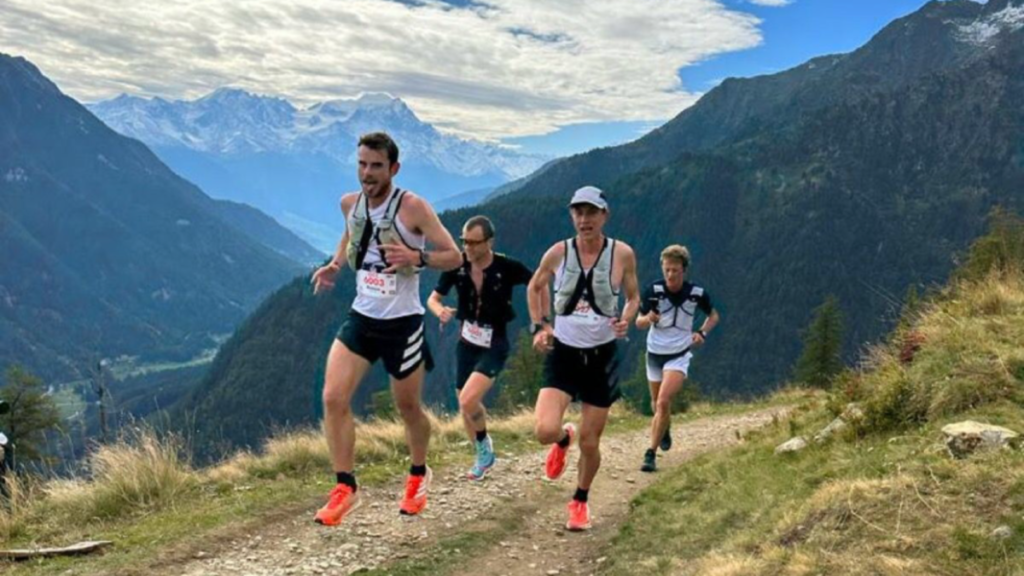
The biggest mistake that I make is increasing my mileage too quickly each spring as I start a new season of training. I will remember my weekly distance from the end of the previous season and try to ramp back up to that within the first month of training. It also doesn’t help that my running club friends are all seasoned ultra runners.
New runners can increase distance by 10% per week until they reach their distance limit. Beyond that distance is increased gradually based on both physical and mental cues. Physically, watch for signs of improved endurance. Mentally, assess your confidence levels about taking on a longer distance.
Let’s take a closer look at the ways we can tell when our body is ready to take on a new distance on the trails so that we don’t suffer injury setbacks.
How Will I Know When My Body Is Ready For A New Trail Running Distance
To determine if your body is ready for a new trail running distance, it’s crucial to pay attention to both physical and mental cues. Physically, watch for signs of improved endurance, such as feeling less fatigued during runs and experiencing quicker recovery times after long runs. Additionally, listen to your body for any pain or discomfort that could indicate overtraining or potential injury.
Mentally, assess your confidence levels and overall mindset towards taking on a longer distance. Feeling excited and motivated about the challenge ahead is a positive sign of readiness. Conversely, if you are feeling anxious or doubtful, it may be an indication that you need more time to prepare mentally.
By being attuned to these physical and mental cues, you can better gauge your body’s readiness for a new trail running distance. Remember, it’s essential to trust your instincts and not push yourself beyond your limits to avoid injury and setbacks in your training journey.
Gradual Increase in Mileage
To prevent injuries and effectively gauge readiness for longer trail running distances, the gradual increase in mileage is crucial. By slowly increasing the distance of your runs, you allow your body to adapt and strengthen gradually, reducing the risk of overuse injuries. This method also helps in assessing your physical capabilities and endurance levels accurately.
Runners can safely ramp up their mileage by following a structured training plan that includes incremental increases in distance each week. It’s essential to listen to your body and pay attention to any signs of fatigue or discomfort during the process. Incorporating rest days into your training schedule is equally important to allow for proper recovery and muscle repair.
Additionally, cross-training activities like strength training and flexibility exercises can complement your running routine and reduce the impact of mileage buildup on your body. By prioritizing a gradual increase in mileage and being mindful of your body’s signals, you can prepare yourself effectively for tackling longer trail running distances with confidence and reduced risk of injury.
Consistent Performance on Current Routes
Consistent performance on your current trail running routes serves as a valuable indicator of your readiness to tackle longer distances. By tracking your performance on familiar routes, you can gauge your progress, endurance, and overall fitness level. Consistency in your running times, perceived effort, and recovery post-run can provide insights into your physical preparedness for more challenging trails.
Monitoring your performance allows you to identify patterns and improvements over time. If you consistently meet or exceed your time goals, feel strong throughout the run, and recover well afterward, it indicates that your body is adapting effectively to the current demands. This consistency demonstrates that your body is becoming more efficient at handling the existing distances, which is a positive sign for taking on longer trail running routes.

Furthermore, observing consistent performance can boost your confidence and mental preparedness for new challenges. When you see improvements in your times or feel more comfortable on familiar routes, it can motivate you to push your boundaries and explore longer distances with a sense of accomplishment and readiness.
Recovery Time After Long Runs
Recovery time after long trail runs plays a crucial role in assessing readiness for increased distances. By monitoring how your body recovers after these demanding runs, you can gain valuable insights into your physical condition and readiness to tackle longer distances. Adequate recovery time is essential for muscle repair, glycogen replenishment, and overall recovery of the body’s systems.
Monitoring recovery can help you determine when it’s appropriate to push for longer runs. If you find that your recovery time is decreasing between long runs, it indicates that your body is adapting well to the stress and is becoming more efficient at recovering. On the other hand, if you notice prolonged recovery times or persistent fatigue, it may be a sign that your body needs more time to adapt before increasing the distance.
By paying attention to your recovery patterns, you can make informed decisions about when to progress to longer trail running distances. Understanding how your body responds to the demands of long runs can guide you in optimizing your training schedule and avoiding overtraining, ultimately leading to improved performance and enjoyment on the trails.
Feeling Energized During and After Runs
Feeling energized during and after trail runs is a key indicator of readiness for longer distances. It signifies that your body is efficiently utilizing energy and recovering well from the physical exertion. Runners should pay attention to their energy levels during runs, as a consistent feeling of vitality can indicate that their body is adapting positively to the demands of the activity.
Distinguishing between healthy fatigue and overexertion is crucial. Healthy fatigue is a natural response to physical activity and can be managed with proper rest and nutrition. On the other hand, overexertion can lead to prolonged fatigue, decreased performance, and increased risk of injury. Runners should listen to their bodies, noting any persistent feelings of exhaustion or sluggishness that may indicate overtraining.
By maintaining a balance between pushing their limits and respecting their body’s signals, runners can ensure they are adequately prepared for longer trail running distances. Prioritizing feelings of energy and vitality can help runners optimize their training, prevent burnout, and enhance their overall performance on the trails.
Ability to Maintain Proper Form
Maintaining proper form during trail runs is crucial for assessing readiness for longer distances. Proper form not only enhances running efficiency but also reduces the risk of injuries that can hinder training progress. Runners should focus on aspects such as posture, foot strike, arm movement, and breathing to ensure optimal performance and minimize strain on the body.
Assessing form can be done through video analysis, feedback from experienced runners or coaches, and self-awareness during runs. Making necessary adjustments may involve strengthening specific muscle groups, improving flexibility, or correcting running mechanics. By addressing form issues early on, runners can prevent compensatory movements that may lead to overuse injuries.

Consistently monitoring and refining running form can help runners build the endurance and resilience necessary for tackling longer trail distances. It allows for more efficient energy expenditure and better biomechanical alignment, ultimately improving overall performance on the trails. Prioritizing proper form as a key indicator of readiness can set the foundation for successful progression in trail running.
Mental Preparedness and Confidence
Maintaining mental preparedness and confidence is paramount when considering readiness for longer trail running distances. The psychological aspect of running plays a significant role in pushing boundaries and overcoming obstacles. Runners must cultivate a positive mindset, visualize success, and develop coping strategies for challenging moments during runs.
Building mental resilience involves setting realistic goals, breaking down longer distances into manageable segments, and practicing mental toughness techniques such as positive self-talk and mindfulness. Additionally, incorporating mental training exercises like visualization, meditation, and relaxation techniques can help runners stay focused and motivated during demanding trail runs.
Confidence in one’s abilities and mental fortitude can be nurtured through consistent training, positive reinforcement, and learning from past experiences. By embracing challenges, staying adaptable, and maintaining a growth mindset, runners can enhance their mental preparedness and confidence levels, ultimately paving the way for success in conquering longer trail distances.
Consistent Training Regimen
A consistent training regimen is essential for preparing the body to tackle longer trail running distances effectively. By following a structured training plan, runners can gradually build up their endurance, strength, and stamina, reducing the risk of injury and burnout. Consistency in training allows the body to adapt to increasing demands, improving cardiovascular fitness, muscle strength, and overall performance.
To structure their training for optimal progression, runners should incorporate a mix of long runs, speed work, hill training, and cross-training activities like strength training and yoga. Gradually increasing mileage each week, incorporating rest days for recovery, and listening to their body’s signals are key components of a successful training regimen.
Setting specific goals, tracking progress, and adjusting the training plan as needed based on performance and feedback are also crucial for long-term success. By staying consistent, disciplined, and committed to their training routine, runners can enhance their physical capabilities, mental resilience, and overall readiness for taking on new trail running distances.
Listening to Your Body’s Signals
Listening to Your body’s signals and cues is crucial in gauging readiness for tackling longer trail running distances. By paying attention to subtle signs such as fatigue, muscle soreness, breathing patterns, and overall energy levels, runners can adjust their training intensity, duration, and recovery strategies accordingly. Developing mindfulness during runs involves being present in the moment, focusing on body sensations, and acknowledging any discomfort or pain without pushing through it recklessly.
Mindfulness techniques like deep breathing, body scans, and visualization can help runners stay connected to their bodies and recognize when to push harder or dial back the intensity. By cultivating this awareness, runners can prevent injuries, optimize performance, and enhance their overall running experience. Ignoring your body’s signals can lead to overtraining, burnout, and potential setbacks in your training progress. Therefore, by listening attentively to what your body is telling you, you can make informed decisions about when you are truly ready to take on new trail running challenges.
Successful Completion of Similar Distances
Successful completion of similar distances serves as a crucial benchmark for determining readiness to advance to longer trail running distances. By achieving success in running distances that are comparable in length and difficulty to the new challenge, runners can build confidence, assess their physical capabilities, and evaluate their overall preparedness.
Runners can use past achievements as a gauge to measure their progress and readiness by comparing factors such as their pace, recovery time, and overall performance during these runs. Successfully completing similar distances not only demonstrates physical endurance but also mental resilience and strategic planning. It allows runners to identify areas for improvement, adjust their training regimen accordingly, and set realistic goals for future endeavors.
Moreover, past accomplishments can serve as motivation and inspiration, reminding runners of their capabilities and pushing them to strive for new challenges. By reflecting on their achievements in similar distances, runners can gain valuable insights into their strengths and weaknesses, helping them make informed decisions about when they are truly prepared to tackle longer trail running distances.
Assessment of Recovery Between Runs
Assessment of Recovery between Runs is a critical aspect of determining readiness for advancing to longer trail running distances. By evaluating how well the body recovers between runs, runners can gauge their physical condition and readiness for increased mileage. Monitoring factors such as muscle soreness, fatigue levels, and overall energy levels can provide valuable insights into the body’s ability to handle the demands of longer distances.
Optimizing recovery strategies is essential for improving performance and preventing injuries. Runners can enhance their recovery by incorporating techniques such as proper hydration, nutrition, stretching, foam rolling, and adequate rest. Additionally, cross-training activities like yoga or swimming can help in promoting recovery and reducing the risk of overtraining.
By paying close attention to their recovery process, runners can make informed decisions about when to progress to longer distances. Understanding the body’s signals and adapting recovery strategies accordingly can lead to improved performance, reduced fatigue, and overall better readiness for tackling new trail running challenges.
Consultation with a Coach or Experienced Runner
Seeking advice from a coach or experienced runner is invaluable when contemplating advancing to longer trail running distances. Mentors bring a wealth of knowledge and experience that can assist in assessing readiness and planning training effectively. A coach can provide personalized guidance tailored to an individual’s specific needs, helping to identify strengths and areas for improvement. They can offer structured training plans, advice on proper pacing, and techniques to prevent injuries.
Experienced runners can share practical insights and firsthand experiences that can be incredibly beneficial. They can offer tips on nutrition, hydration, gear selection, and mental strategies for tackling longer distances. Mentors can also help in setting realistic goals, monitoring progress, and making adjustments to training as needed.
By consulting with a coach or experienced runner, trail runners can benefit from a supportive and knowledgeable resource that can enhance their preparation for new challenges. Their guidance can instill confidence, provide motivation, and ensure that runners are adequately equipped both physically and mentally to take on longer trail running distances.
